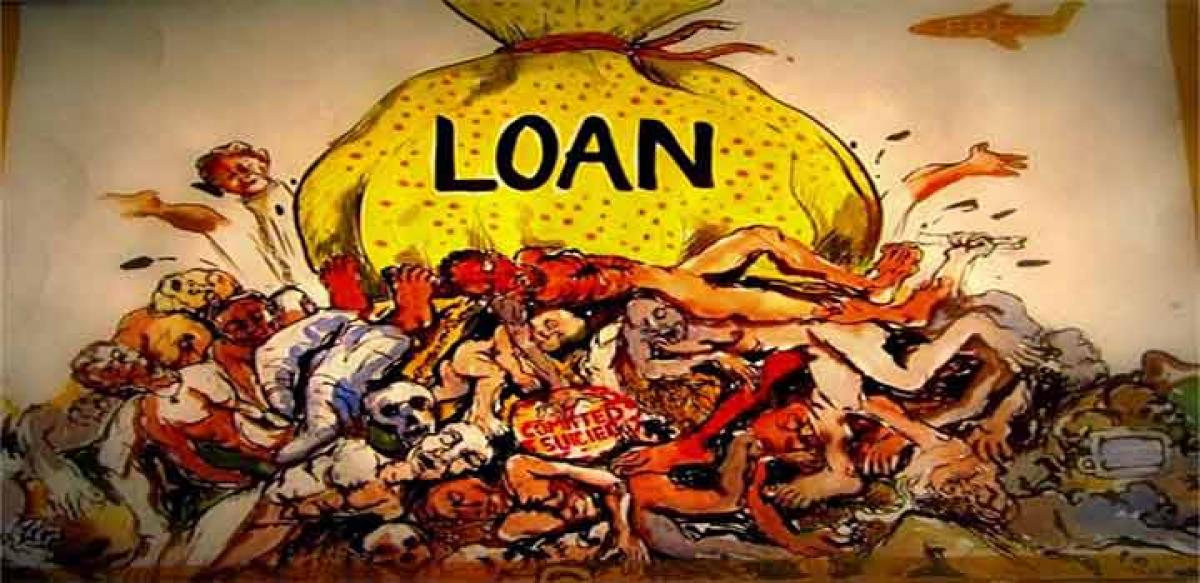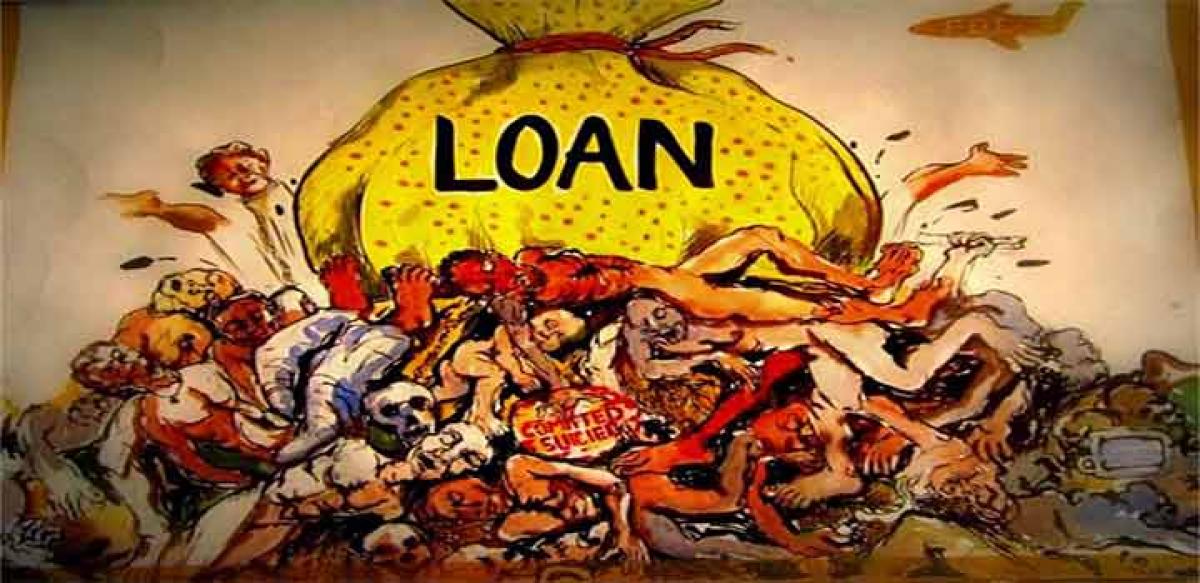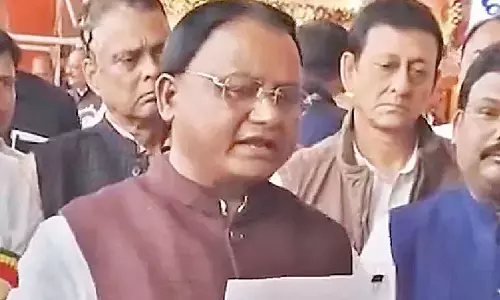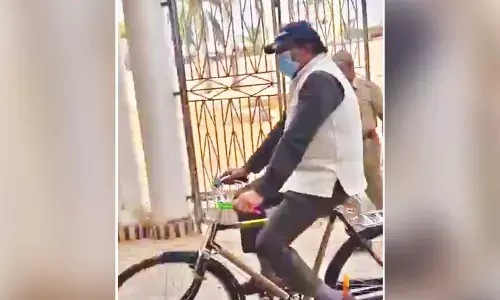An action plan to save farmers

The political pandemonium on the increasing number of farmers committing suicides is not just depressing but preposterous. The blame game between the ruling and the opposition parties is totally distasteful.

Agriculture by its very nature cannot so easily be made viable. Even the developed nations highly subsidise agriculture. Besides, agricultural incomes are very uncertain and unpredictable.
The society certainly doesn’t require parochial political cacophony but a serious analysis of the problem and practical solutions to the agrarian crisis whose extreme manifestation is the phenomenon of farmers’ suicides.
A disaggregated view of the unfolding tragedy reveals that small farmers, tenant farmers, farmers in dry land areas, and those who took to commercial farming are in higher proportion among the farmers committing suicide.
This indicates that the spectre of suicides is not social and psychological phenomena but predominantly and intricately linked to the economic process that makes small, tenant, dry land, commercial farming highly unsustainable. The solutions demand multiple interventions
The political pandemonium on the increasing number of farmers committing suicides is not just depressing but preposterous. The blame game between the ruling and the opposition parties is totally distasteful.
The society certainly doesn’t require parochial political cacophony but a serious analysis of the problem and practical solutions to the agrarian crisis whose extreme manifestation is the phenomenon of farmers’ suicides.
Philosophers have interpreted the world in many ways but the thing is to change it. This philosophical dictum should urgently prevail over our political leadership who has seen a political opportunity even in the tragic death of helpless farmers who feed us.
The structural factors make agriculture a negative economic proposition. The sad experience of crop holidays called by farmers in the united Andhra Pradesh illustrated the pathetic plight of agrarian economy.
Farmers do not need loan waivers. But, what is required is to prevent farmers from becoming debt-ridden. The National Sample Survey (NSS) data reveal that the two states – Andhra Pradesh and Telangana – rank at the top in terms of peasant indebtedness.
Summing up the crisis in agriculture, the Jayati Ghosh Committee report rightly observed, “The economic strategy has systematically reduced the protection accorded to farmers and exposed them to market volatility and private profiteering without adequate regulation, has reduced critical forms of public expenditure, has destroyed important public institutions and did not adequately generate other non-agricultural and economic activities."
A reversal of this economic strategy and a paradigm shift in public policy would only reverse the trend of suicides. Instead of introducing such a policy change, the governments driven by political expediency are busy announcing attractive special packages to induce farmers from distress to death. However, such a relief package cannot be rejected as it at least provides some succor to the bereaved family.
A disaggregated view of the unfolding tragedy reveals that small farmers, tenant farmers, farmers in dry land areas, and those who took to commercial farming are in higher proportion among the farmers committing suicide.
This indicates that the spectre of suicides is not social and psychological phenomena but predominantly and intricately linked to the economic process that makes small, tenant, dry land, commercial farming highly unsustainable.
The solutions demand multiple interventions. A comprehensive action plan should encompass all these critical interventions. The unviable nature of our farming is directly related to low levels of productivity especially in dry land areas.
The spatial inequalities in access to irrigation create a clear asymmetry between dry land and wet land farmers, though the agrarian crisis is affecting the farmers as a whole.
The inadequate and inefficient canal irrigation in Telangana has led to unsustainable use of groundwater resources. We are now withdrawing more water from Earth’s aquifers than their regenerating capacity.
The policy shift from expanding irrigation to providing free power has led to unsustainable use of scarce water resources. The indiscriminate spread of bore well technology has further aggravated the problem.
Therefore, a sustainable water management and natural resource management are the need of the hour. Conservation of water bodies, conjunctive use of surface and ground water, scientific practices in water use etc., should form the tenets of any such strategy on managing water economy.
The immediate provocation that pushes the farmer to commit suicide is the unbearable burden of debt. The indebtedness is not the result of crop losses alone but is accentuated by rising costs of health and education.
Expanding institutional credit making it accessible to all types of farmers, especially small and tenant farmers, and covering all kinds of credit requirement can only liberate them from the clutches of oppressive private money lenders.
But, this should be accompanied by encouraging recovery culture and a comprehensive crop insurance with farmer and more precisely the survey number as a unit otherwise either farmer or the financial institution can go bankrupt.
The dry land farmer is the most suffering segment of the farming community. Low levels of productivity, uncertain monsoons, adverse impact of climate change, ineffective contingency plan make the life of a dry land farmer miserable.
Therefore, the public policy should focus on dry land farming through technology, extension, price and other incentives. The farmer in both dry and wet lands should be insulated from the vagaries of nature. The increasing vulnerability of agriculture to natural calamities like drought and floods is dampening agrarian economy.
Farmers face innumerable problems in input availability. The cost of inputs continues to rise at a much rapid pace as compared to the price of the agricultural produce, making agriculture a non-viable economic activity.
The NSS data reveal that more than 40 per cent of farmers are willing to abandon agriculture if any other suitable occupation is available.
The census data also indicate that the farmer is an endangered species as the number of cultivators is declining decade after decade, indicating the phenomenon of missing farmers.
The manufacturing sector is inadequately developed, thereby limiting its capacity to absorb the work force displaced by agriculture in distress.
There is no regulation whatsoever on the quality, pricing and supply of inputs thus exposing farmers to rapacious private profiteering. Meanwhile, farmers are subjected to high amplitude of fluctuation in prices of agricultural commodities.
The volatility of agrarian markets intensified with the process of globalisation as our farmer is exposed to the vicissitudes of global market place. The liberalised cheap agricultural imports are proving to be a death knell. Such an indiscriminate import liberalisation is eroding the domestic agricultural production, increasing the income insecurity of our farmers.
On the other hand, the average farmer who holds a small land holding with his limited production can hardly benefit from global price increases.
Agriculture by its very nature cannot so easily be made viable. Even the developed nations highly subsidise agriculture. Besides, agricultural incomes are very uncertain and unpredictable.
The solution therefore lies in rural economic diversification, more value-added activities and non-agricultural activities. The allied sectors like dairy, fisheries, forestry, poultry etc., can augment farmers’ incomes and insulate them from income volatility induced by unsustainable agriculture.
The middle men rule the agricultural markets. The utter lack of storage facilities and high post harvest losses force the farmer to distress sale.
This results in income insecurity to the farmer and food insecurity to the consumer. Effective food management system should include production, procurement, storage and distribution. The supply chain efficiency needs to be substantially raised.
Such a new agricultural growth trajectory can only be implemented with increased public investment in agriculture, allied sectors and related rural infrastructure.
The increased public expenditure is much more essential at a time when there is a disaggregation of land holdings. The politics has made the cooperative farming largely defunct. But, at least common pool of agricultural implements, networked agricultural markets should be encouraged.
The monsoon management with a focus on climate smart cereals can address the twin problems of vulnerability to climate and nutritional insecurity of the poor households. The unregistered tenant farmers, the assignee farmers face innumerable difficulties in accessing public provisioning of inputs like seeds, credit, insurance, relief etc.
The delicate land relations are driving the tenant farmer to a catch-22 situation. A radical policy shift rather than expedient politics will save the farmer from brink of an apocalypse.

















